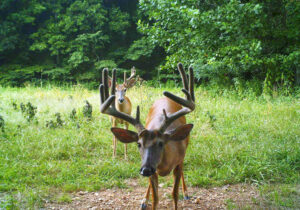Three Deer Management Strategies
Any time is a good time to start developing your deer management strategy. The important thing is to have a strategy so you can achieve your goals. If you are anything like me, you dream about those goals for a large portion of the year. With a little strategizing those goals and dreams have a higher chance of becoming a reality. The first step is figuring out what your goals truly are. Would you like to see lots and lots of deer no matter the size? Maybe you need to trim numbers to minimize your farm’s crop damage. Maybe your goal is to see tons of deer sign – scrapes and rubs, and observe an intense rut where bucks are competing for does? Or, a goal that is becoming more popular is “to harvest the largest buck in the county.”
There are generally three categories of herd management: Traditional Deer Management, Quality Deer Management, and Trophy Deer Management. Let’s look at the differences.
Traditional Deer Management
Traditional Deer Management is what many of us grew up with through the1970s, 80s and 90s. This was a time of expanding deer herds. State regulations generally favored buck harvests over doe harvests with many gun seasons being “buck only.” This was a great method of increasing deer populations from their record low numbers in the early 1900’s. More and more deer were seen every year. During my first deer camp experiences my great uncle would often reminisce about Iowa deer seasons in the 1950s and 60s when seeing one deer per season was a real treat and you had better make a good shot because you weren’t getting another.
Under this management plan populations grew while the buck harvest was maximized, mainly taking out one year old bucks. This meant only a small percentage of bucks reached two years old, even fewer reached three years old, and relatively few, if any reached the older age classes.
Quality Deer Management
Quality Deer Management is the pro-motion of healthy deer populations in a more natural state, before more modern hunters affected their populations. This includes promoting a more balanced sex ratio between bucks and does – basically for every doe or two you see you should see a buck, and balanced aged structures – allowing bucks to be present in all age classes, from one year old through seven plus years old. This type of management generally improves the timing and intensity of the rut (improves buck response to grunting and rattling), increases rutting sign through the production of scrapes and rubs, and improves fawn recruitment and antler growth.
QDM does require a little more work because thought has to be put into how many does should be harvested to maintain the balanced sex ratio, bucks need to be allowed to reach older age classes primarily through trigger finger management (“let them go so they can grow”) and considerations of how habitat management affects the deer herd.
Trophy Deer Management
Trophy Deer Management has the primary goal of producing high quality bucks. This requires intense work in making sure that all of a buck’s needs are met from conception to maturity. This includes balancing the sex ratios and age structure. In fact, if possible the sex ratio can actually be skewed in favor of the bucks so there is intense competition for breeding rights. Ample high quality forage must be available.

Since bucks don’t produce their largest antlers until five to seven years old, high quality bucks must be able to make it to these ages classes consistently. The population must be kept at a low level, often below what most hunters would enjoy, to ensure the highest quality forages are available year-round for milk production and fawn rearing, and so the bucks have what they need for producing antlers. With hunters being the main player in population control, if a property is not in a high fenced area, it can take five thousand plus acres to accomplish, allowing the manager extensive control of what deer are harvested.
So, where do you feel your interests fall? If you are unsure it may be good to know that the growing trend across the whitetail’s range is Quality Deer Management. All three management styles have their positives and negatives, but as a biologist this is the type of management I tend to lean toward – a healthy deer herd, plenty of deer to observe, bucks competing during the rut, and a population in tune with its habitat.
Did I also say bucks competing during the rut? I had to repeat that one because one of my favorite things to do from the stand is to run my grunt call. Almost like a tom turkey gobbling at my hen call, bucks responding to my call by trotting through the leaves toward me, sends my heart racing. Since grunt calls work well when there is a moderate deer population and competition for does in a herd with a balanced adult sex ratio, Quality Deer Management is the plan for me.
Having the opportunity to develop and fulfill a management plan, no matter which one you pick, is a thrilling experience. You as a deer hunter are a deer manager and are in a unique situation to create your own experiences in the field. Don’t be afraid to metaphorically “grab the buck by the antlers” and develop a plan that works best for your goals and dreams.
~
For more from GameKeeper Farming For Wildlife, join our weekly newsletter or subscribe to GameKeepers Magazine. Your source for information, equipment, know-how, deals and discounts to help you get the most from every hard-earned moment in the field.








